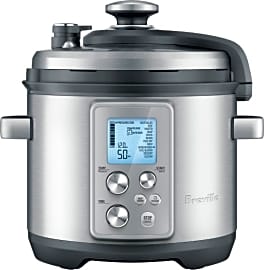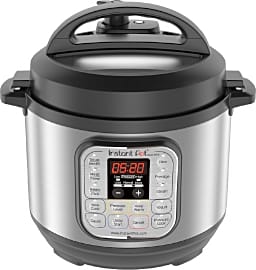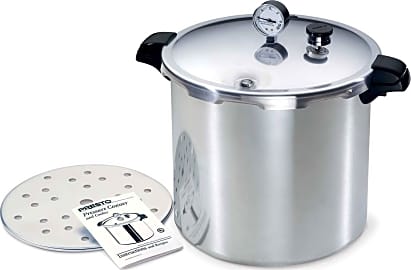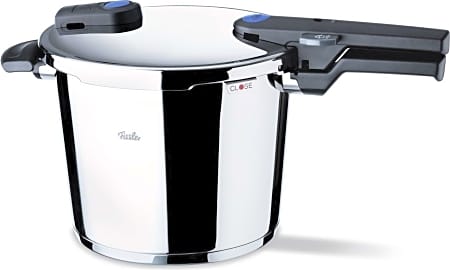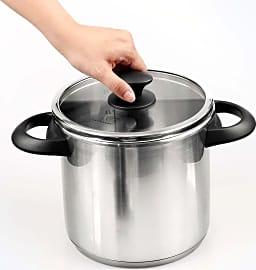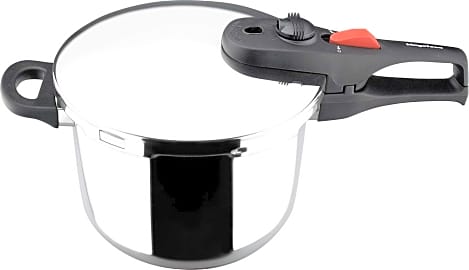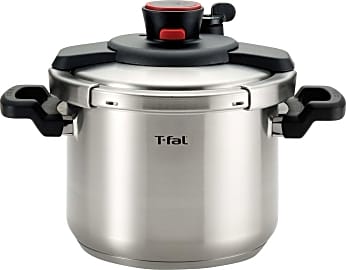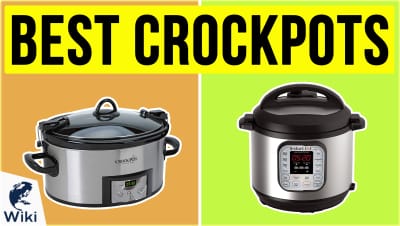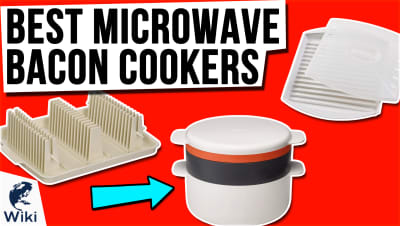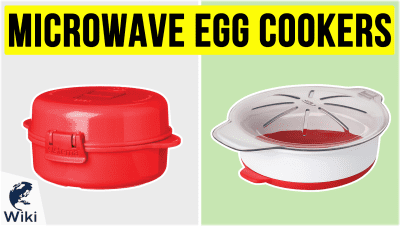The 10 Best Pressure Cookers

This wiki has been updated 43 times since it was first published in May of 2015. Pressure cookers not only work faster than many other cooking methods, but they can also help you save energy, too. They make preparing traditionally slow-cooked recipes, like stews and braised meats, much more convenient. However, it is important that you adhere to all of the manufacturer's usage guidelines, as they have the potential to cause injury if used incorrectly. When users buy our independently chosen editorial recommendations, we may earn commissions to help fund the Wiki.
Editor's Notes
April 13, 2021:
With all of our previous picks for this category still being available and presenting as excellent selections for the category, we didn’t see any pressing need to make major changes to this list, and so moved through this round of updates without making any meaningful modifications.
We did notice that the three-quart Instant Pot Duo Mini seemed to be suffering from some availability issues at the time of this writing, but we can only assume that this is the result of a temporary supply shortage, knowing this to be a popular unit and observing that it was still available through alternate vendors.
Pressure cookers are often thought to be a must-have for users interested in preserving jarred goods, but if the biggest thing you’re interested in is cooking roasts and stews, then you might also be interested in checking out our list of crockpots.
January 16, 2020:
Pressure cookers may be intimidating at first, and in truth they do have the potential to cause injury if used incorrectly, but after using one to prepare a few meals in a fraction of the time it would normally take, you'll wonder how you ever made do without one.
During this update, we removed the Elite Platinum as we didn't feel it offered anything that justified its very high price, especially when compared to the Instant Pot Smart 8-in-1, which can do everything the Elite Platinum can, but with the added convenience of Wi-Fi control. If you don't need Wi-Fi control and think a six-quart pot is too large for your needs, there is also the Instant Pot Duo Mini, which also offers enough cooking features to satisfy the most demanding of consumers.
We also decided to replace the Presto 01781 with the Presto Canner 01784, since the latter is induction stove compatible, whereas the former was not. As you can probably gather from the names, along with the Presto Canner 01784, the All American Canner is also suitable for canning fruits, vegetables, and meats. On that note, we would like to point out that while you could easily use a canner for pressure cooking, it is best not to do the opposite as pressure cookers generally don't allow as precise control over the pressure, which is vital for canning food safely.
The Instant Pot Duo Mini, Instant Pot Smart 8-in-1, Breville Fast Slow Pro, and Cuisinart CPC-600 are all plug-in models that offer a lot of pre-set programs, which can make them easier to use for beginners since they won't have to worry so much about setting the cooking time and pressure themselves. However, if you prefer a more hands-on approach, you may want to look at the All American Canner, Presto Canner 01784, Fissler Vitaquick, Culina One-Touch, Magefesa Practika Plus, and T-fal P45007 Clipso, which are all stovetop options.
Special Honors
Direct Industry Commercial Cookers If you're looking to significantly scale up your meal production, this company offers a number of industrial-sized options that might be able to get the job done. Just note that it isn't made explicitly clear what pressure these steamers achieve, which may be a dealbreaker for some. directindustry.com
LabX Sterilizers If the primary purpose you have in mind for this pressure cooker is sterilizing scientific samples, as opposed to preparing quick meals, then you might be interested in checking out some of this company's solutions. Granted, most options will be too pricey for most users, but it's still interesting to take a look at what's out there, and maybe you'll even set your sights on an aspirational purchase. labx.com
High Pressure With Less Stress
The higher the pressure, the less time it takes to get dinner on the table.
Most people who enjoy cooking have an arsenal of utensils at their disposal to get the job done. Both home and professional chefs have a passion for creating delicious meals for themselves, their families, their guests, and friends. While there's nothing wrong with using an oven or soup pot on top of a burner to make a hot meal, those aren't the only ways to cook these days. Perhaps you'd like the benefit of rapidly cooking a wide variety of foods in other ways besides using a conventional burner or the heat of an oven. The pressure cooker can be quite a useful alternative for this purpose.
As its name implies, a pressure cooker is a semi-sealed cooking pot that operates through the buildup of internal steam pressure to prepare foods faster than they would ordinarily be prepared from inside an oven or on a stovetop. The majority of pressure cookers are ideal for preparing meals with liquids such as water, wine, broth, or stock. The act of sealing these liquids inside the pot traps the vapor they release as the internal temperature of the vessel rises.
This rise in temperature also increases the degree of internal pressure that is infused into whatever food is being prepared while the maximum possible temperature is also increased, thereby cooking a meal faster than more conventional methods. This may explain why that delicious beef stew you've prepared is so flavorful, moist, and ready to serve ahead of schedule. The amount of internal pressure inside the vessel is inversely proportional to the amount of time it takes to prepare a meal. The higher the pressure, the less time it takes to get dinner on the table.
Pressure cookers are usually constructed from either aluminum or stainless steel. Stainless steel cookers are typically more durable and less reactive to acidic foods than aluminum cookers. These vessels have several parts and accessories, including a steamer basket for holding food, a trivet for keeping the steamer basket above the liquid inside, a spring-loaded valve for controlling the release of excess steam and regulating pressure, and a sealing ring (or rubber gasket) for retaining heat. The lid on a pressure cooker locks into place against the side of the pot, while its handle also locks to prevent the lid from opening when food is under pressure. The vessel has a standard operating pressure up to fifteen pounds per square inch (PSI). Under this level of pressure, water boils at two hundred fifty degrees Fahrenheit.
So what types of things can actually go into a pressure cooker? The short answer is a lot. For example, rice and beans can be quickly prepared, meats can be tenderized, and the infusion of both heat and moisture makes the flavors of one's food more intense. Foods prepared in this fashion also retain a greater percentage of their nutrients and vitamins than they would when boiled or commercially processed, adding an important health benefit to the pot. Finally, the vessel has an impressive degree of versatility. It can be used as a dutch oven, steamer, sauce pan, and even a baking pan.
Get Cooking
Some of the best pressure cookers available feature automatic pressure release functionality, which makes preparing meals easier and safer than ever before. If you're a busy parent, finding a vessel with the most cutting-edge technology and a large capacity for liquids and food are both important considerations.
The ability to monitor and adjust the pot's settings is also beneficial.
The ability to monitor and adjust the pot's settings is also beneficial. For that reason, pots with programmable and intuitive push-button displays will come in quite handy. One must also be sure that the pot's sealing system is durable and reliable as well.
Consider the size of your kitchen and other appliances you have available to you when making your decision, as some pots are even compatible with induction cooktops.
If cooking quickly isn't your only source of motivation for investing in a pressure cooker, then you can also find available models with multiple operating modes for slow cooking and making thick sauces.
Finally, one must be sure that the handles make the vessel comfortable and easy to carry without any chance of overheating.
A Brief History Of Pressure Cookers
The earliest known attempt at pressure cooking was made by French physicist Denis Papin who was most well known for his work on steam engines. Papin invented what he referred to as a steam digester in 1679. This airtight cooking device used steam pressure to increase the boiling point of water. In 1809, French confectioner Nicolas Appert invented a canning process for packing food in clean jars with a cork and cooking them in boiling water for food preservation. Although not an actual pressure cooker, Appert's preservation method helped to develop the overall science of pressure cooking itself.
Papin invented what he referred to as a steam digester in 1679.
By 1864, pressure cookers made from tin cast iron were manufactured by Georg Gutbrod of Stuttgart. In 1917, the United States Department of Agriculture determined that pressure canning was the only safe method of preserving low-acid foods without causing food poisoning. With this information, homeowners began to recognize the benefits of using their pressure canners to cook foods more quickly.
By 1918, Jose Alix Martínez was granted a patent for the pressure cooker, which he named olla exprés, meaning express cooking pot. Martínez later published the very first pressure cooking pot recipe book in 1924 that included 360 unique ideas for preparing food in the vessel.
In 1938, Alfred Vischler introduced the first saucepan-style pressure cooker for home use in New York City, which he called the Flex-Seal Speed Cooker. Popularity of the vessel took off with even greater success in 1939 when National Presto Industries released its first pressure cooker at the New York World's Fair. By 1941, eleven companies were manufacturing pressure cookers for the home consumer market.
Following World War Two, stamped aluminum cookers became more common for those on tight budgets during the 1950s. Both contemporary styling and the addition of extra safety features were introduced in the 1970s, such as an interlocking cover that prevented the user from opening the vessel without first reducing the amount of pressure inside it. Today, the United States standard for pressure cookers continues to be the type equipped with a weighted valve regulator.



